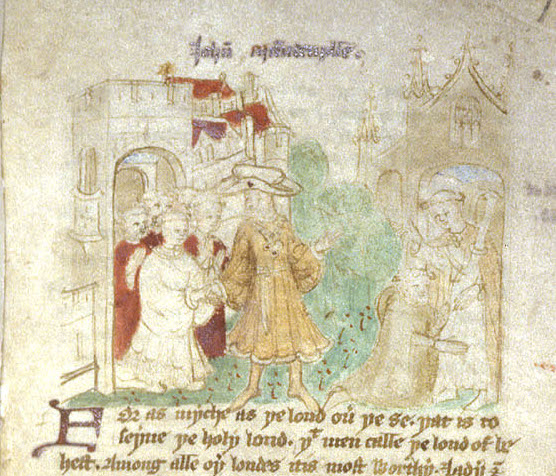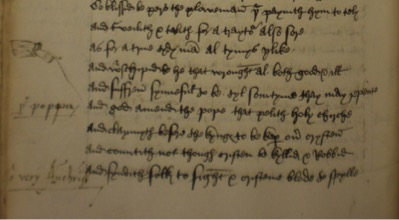When first “published” in the fourteenth-century, William Langland’s Piers Plowman and the Mandeville-author’s The Book of Sir John Mandeville, each in their own right, went viral. As the number of extant manuscripts for both works suggests,[1] they took the English nation by storm in the early decades of their reception history, not as instantaneous explosions that quickly fizzle out like a modern day cat video, but as longstanding bestsellers that deeply influenced the course of England’s intellectual and social history. The organizers of the 1381 Peasant’s Revolt, for example, cite Piers in the famous Letters of John Ball.[2] A copy of Mandeville, scholars enjoy noting, was consulted by Christopher Columbus before his voyages, and the text served as a source of inspiration for many explorers in the so-called Age of Exploration. Indeed, great minds read, used, and cited these texts to various ends for centuries, but rarely, it seems, together. Except, that is, among their earliest readers, at least some of whom saw a natural affinity between them.
Given their coterminous popularity in late medieval England, it seems statistically probable that some, and quite possibly many, avid readers of Middle English would encounter, or at least know about both of these texts. While that surmise might sound less than startling, the idea of these two works occupying space in the same book often elicits surprise in conversations about my work. In fact, Piers and Mandeville circulated together in five known manuscript copies. The original discovery of that information by one of my own undergraduate professors, Anne Middleton, effects just such a response as she remarks that Piers’ “most frequent companion must be rather surprising” (105).[3] This discovery forms the basis of my book project, “Reading Beyond the Borders: Literary Geography and the shared reception of Piers Plowman and The Book of Sir John Mandeville,” in which I examine all five manuscripts in order to uncover this textual pairing’s early reception history. For, to the modern reader tied to culturally specific notions of genre and modern methodologies of reading, Piers and Mandeville can indeed appear to make little sense together. However, when read from the perspective of a medieval reader (to the extent that that is possible in 2017), these two works become much more obvious travel companions.

On the surface level, this pairing shares some key narrative features: their narrators, both English, go on pilgrimage with a didactic mission. David Benson also identifies their common purpose as vernacular forms of “public writing” meant to deliver Latinate, clerical learning to a wide lay and religious audience.[4] Dig deeper, and even more thematic connections emerge: both works explore what it means to be English within the large expanse of global Christendom. The very concept of nationhood itself comes under scrutiny as both narrators delve into the ethics of kingship and enter into dialogue with non-Christians.[5] Both works, moreover, present their own progressive and inclusive versions of universal history, apocalypticism, and salvation (with the egregious exception of Mandeville’s severe anti-Semitism). Likewise, because Piers, a dream vision, and Mandeville, a travel narrative, fold innumerable source texts into their own writing, neither one is confined by the constraints of their primary genres. These connections comprise a mere sampling of the many important issues raised when reading Piers and Mandeville in dialogue with each other, rather than as stand alone texts.
Interestingly, medieval scribes and readers themselves brought many of these concerns to my attention. For, in each of the five manuscripts, they repurpose their copies of the Piers-Mandeville pairing according to their own, often polemical, ends. By anthologizing, revising, annotating, editing, illustrating, rubricating, and otherwise designing every detail of their books, they published and/or read their copies of the Piers-Mandeville pairing in unique, individualized manuscript contexts. Additionally, the varied regional, vocational, and personal backgrounds of these readerships color their reader responses, especially in relation to the specific types of political and ecclesiastical corruption they each prioritize. Ultimately, what is perhaps more surprising than the pairing’s codicological companionship is the relevance of its audience’s responses to recent literary studies in the current age of globalization. These readers, in fact, follow the navigation of two English narrators across national and cultural boundaries, interrogating corrupt and stable governments, the value of public institutions, and the need for interfaith dialogue and cultural exchange.
Thus, rather than comprising two unrelated, isolated events in literary history, these two longstanding bestsellers, influencers of major historical events and movements, jointly stimulated the minds of their shared audiences. This book, therefore, demonstrates that these texts’ lasting impacts on social and intellectual history were not exclusive of each other, and neither was their relevance to the medieval readers who read them as ideal companion pieces.
Karrie Fuller
University of Notre Dame/St. Mary’s College
[1] There are nearly sixty manuscripts of Piers Plowman, and, internationally, around three hundred for The Book of Sir John Mandeville. The most popular Middle English version, known as the Defective text, numbers forty-four. A variation of this version is in each of the manuscripts examined for this project.
[2] For just one of many important studies on this topic, see Steven Justice, Writing and Rebellion: England in 1381 (Berkeley: University of California Press, 1996).
[3] Anne Middleton, “The Audience and Public of Piers Plowman,” Middle English Alliterative Poetry and its Literary Background, ed. David Lawton (Cambridge: D.S. Brewer, 1982), 101-123, 147-154.
[4] David Benson, Public Piers Plowman: Modern Scholarship and Late Medieval English Culture (University Park: Pennsylvania State University Press, 2004).
[5] There is a large body of literature on what the concept of “nation” [natio in Latin, “nacioun” in Middle English] meant in the Middle Ages. For an introduction to the subject, see Kathy Lavezzo’s edited volume, Imagining a Medieval English Nation (Minneapolis: University of Minnesota Press, 2003).



